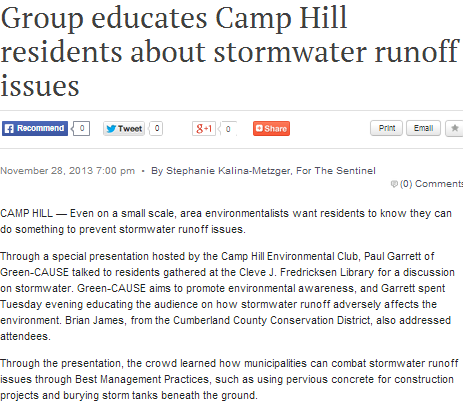Stormwater runoffs have become a major source of urban water pollution. To address the situation, governments, companies, scientists, and various communities have been constantly developing stormwater Best Management Practices (BMP), and disseminating this information to the widest possible public audience. In an article for The Sentinel, Stephanie Kalina-Metzger reports:
Even on a small scale, area environmentalists want residents to know they can do something to prevent stormwater runoff issues.
Through a special presentation hosted by the Camp Hill Environmental Club, Paul Garrett of Green-CAUSE talked to residents gathered at the Cleve J. Fredricksen Library for a discussion on stormwater. Green-CAUSE aims to promote environmental awareness, and Garrett spent Tuesday evening educating the audience on how stormwater runoff adversely affects the environment. Brian James, from the Cumberland County Conservation District, also addressed attendees.
Through the presentation, the crowd learned how municipalities can combat stormwater runoff issues through Best Management Practices, such as using previous concrete for construction projects and burying storm tanks beneath the ground.
Stormwater runoff issues happen when excess water from storms pass through urban passageways before reaching natural drainage channels like oceans, lakes, and rivers and, in the process, gather pollutants and waste materials typically produced in urban locations, including oils, fertilizers, and pesticides. These pollutants can then contaminate natural catch basins and cause damage to its ecological system. Additionally, stormwater runoff is a major cause of urban flooding, which in turn can lead to diseases in humans.
Among the most successful stormwater BMP are the retention and detention of stormwater through systems developed by industry innovators like StormChamber by Hydrologic Solutions. These systems have been designed by experts from several fields including engineering and ecology, to ensure that they result to negligible, if any, negative impact on the environment. Likewise, in keeping with their purpose to preserve natural resources, these stormwater BMP have been created to eventually benefit the consumer.
Collecting stormwater for reuse in homes is a practice that had once been associated mostly with developing countries. However, recent events and developments surrounding the environment caused scientists and concerned groups to take a closer look at this practice and how it can benefit urban locations in Western countries, including the United States. Through state-of-the-art technology, these impressive storm water BMP have adapted the basic elements of stormwater gathering into efficient systems that eventually allow homeowners to reuse filtrated storm water in their homes.
(Article Excerpt and Image from Group educates Camp Hill residents about stormwater runoff issues, The Sentinel, November 28, 2013)






